TNIV Truth: Can the TNIV Be Used for "In-Depth" Study?
Can someone please explain to me how you can use the TNIV for in-depth study? I love the TNIV, but I am having a hard time using it for deep study because of the dynamic equivalence. I don't know if this is a mindset or an actual problem.
To read my response, click here.
Bible Note-Taking: My Method
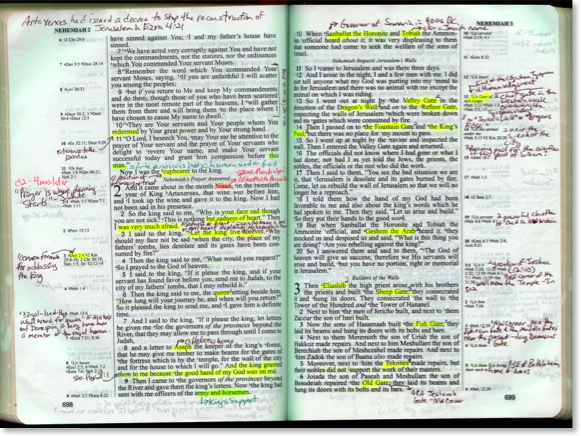
I actually developed it while I was in college, and although I've tweaked it along the way here and there, it's not overly changed from the way it was years ago. I have to admit that the actual structure is based on the colors available in a pack of Stabilo Boss Dry Highlighters. The pack came in five colors. I never figured out what to do with the orange, so I used it elsewhere. However, here is how I arranged my categories:
YELLOW = General and miscellaneous notes that do not fall into other categories.
RED = Dates, chronology, date of composition
GREEN = symbolism, metaphor, literary features
BLUE = Messianic, Christological
With each of the dry highlighters, I use a corresponding pen for my annotations with the exception of the first category for which I use a black pen. In other words, I highlight in yellow, but the corresponding note is in black, unlike the other colors for which I have matching highlighter and pens.
The main Bible I take notes in is a NASB wide-margin single column reference Bible from Foundation Publications. I would be willing to use a more contemporary version such as the TNIV or NLT, but no adequate wide margin Bible is available in these translations. I make these annotations whenever I study a passage (using commentaries and other reference works) for personal edification or teaching others. I make different kinds of notes in a Greek NT, usually grammatical issues relating to the Greek text or a gloss of a rarely used word that is not in my memorized vocabulary.
Here are some random examples of the kind of annotations I've got marked in my NASB wide-margin Bible:
GENERAL AND MISCELLANEOUS NOTES
- In Gen 45:4, I have the word alive highlighted in yellow. In the margin I have the words "meaning 'enjoying health and well-being.'" I have no idea where I got this information--probably from a commentary. I will list a source for extended notes, but not short comments like these.
- Sometimes I merely write annotations without highlighting anything specific. For instance, In the top margin above 2 Sam 13, I have "reminder" bullets: • Absalom and Tamar were David's children by Maacah, daughter of the king of Gesure; and • Amnon Was David's son by Ahinoam, the Jezruelitess.
- At Neh 4:3, I have highlighted in yellow the words "break their stone wall down." In the margin are the words, "Actually archaeological discoveries have revealed Nehemiah's wall to be four feet thick--NAC." In this case, I did note the source: the New American Commentary. I could have just as easily noted the author instead of the series, but more than likely, the series would make a more familiar reference in this case.
- At Neh 3:13, Zanoah is highlighted in yellow with the accompanying note, "13 mi. sw of Jerusalem."
- Sometimes the notes will reflect alternate translations. In Neh 5:7, I highlighted the words "I consulted with myself" and in the margin have the note "lit. 'my heart took counsel upon me.'"
- Certain books like Job are heavily annotated. In this case, I was doing personal study through Job at one point, and then I've taught the book a few times.
- In many places throughout the Bible, I'll highlight a word in yellow, and in the margin or very close to it, write the actual underlying original language word.
DATES AND CHRONOLOGICAL ISSUES
- In Jer 1:2, I highlighted in red the phrase, "the thirteenth year of his reign." The corresponding note (written in red ink) says 627 BC.
- I highlighted in red the Hebrew month "Nisan" with the corresponding note "spans March-April; 1st month of the Persian year." Similarly at Neh 9:1, I highlighted the phrase "the twenty-fourth day of this month" with the annotation "Oct 30, 445 BC."
- I have a note in red at Acts 6 that these events occur five years after Pentecost.
- At the beginning of books, I often try to list suggested dates of composition. For instance in Matthew, I have a number of suggestions including on the more conservative side: "60's <70" from Carson, Moo, & Morris' NT Intro and "After 70" from Kümmel's more progressive NT Intro. Because these types of annotations come at the beginning of the book, I sometimes write other introductory notes in red as well such as suggested authors, but I don't do this consistently, it seems.
- I occasionally use red for brief outlines and structural notes.
SYMBOLISM/METAPHOR/LITERARY
- I highlighted "with fasting, in sackcloth and with dirt upon them" in green and my corresponding note written in green says "mourning and humility." This kind of note seems unnecessary after a while. I simply "know" that kind of information. Do I really need to make a note of it? And yet, I tend to add that kind of notation anyway for teaching purposes as it reminds me to mention it in an instructural setting.
- In Job 1:2 I have highlighted "Seven sons and three daughters" with the annotation "The symbolism of the numbers imply that Job had an ideal family." This kind of note gets a lot of play in a book like Revelation, where I have quite a bit of green.
- In Psalm 74:19, turtledove is highlighted with the simple annotation "Israel."
- A passage like Eccl 12:3-6 is loaded with symbols. "watchmen of the house" = arms, "mighty men" = legs, "grinding ones" = teeth, etc. I have all of these highlighted in green with accompanying annotations written in green.
- I use green for the many euphemisms in a book like Song of Solomon.
MESSIANIC/CHRISTOLOGICAL
- This turns out to be my least used color, perhaps because it could be overdone, especially in the gospels and become meaningless. Often annotations that could receive blue treatment simply get highlighted in yellow.
- Since the NASB wide margin that I use has a cross reference system, I often will highlight in blue the cross references between the testaments referred to in messianic prophecies. Surprisingly, often I find that the references aren't included both ways and I will have to write one of them in using a blue pen.
- In Rev 5:5, I have Lion highlighted in blue with an annotation written in blue that says "conquering warrior messiah." Then in v. 6, I have the accompanying Lamb highlighted in blue with the note "sacrificial death; links the Messiah to the passover lamb." I also have a note written in blue with v. 6, but not directly related to anything specifically highlighted, that says "Here John joins the OT Davidic Messiah and the Suffering Servant of Isaiah (Isa 52-53)." I really should have listed my source for that because I doubt it was my own original conclusion. It may have come from John Newport's book, The Lion and the Lamb.
Obviously, there are thousands of other examples, but the above are a sampling which I believe gives the flavor for what I am doing.
The actual Stabilo Boss Dry Highlighters are no longer made, but are still available on eBay. I have stocked up on enough to last for a very long time. The dry highlighters I usually see in stores these days are the Staedtler dry highlighters. To me these are a perfectly suitable replacement, except for the yellow pencil which makes me continue to seek out the older highlighters.
For years, I used ballpoint pens for my corresponding notes, with green ballpoints always the most difficult to come by. Noticing that some of my oldest notes were starting to bleed through, and I began to look for something else. A number of readers for this blog suggested the Pigma Micron pens. These are what I use exclusively in my Bibles now, and having experimented with different nib sizes, settled on a 01 point for writing in my Bibles. I like these pens so much, I use the larger nibs for grading papers and writing in my Moleskine journal.
I also discovered that Pigma Micron has a brown pen. I like the color brown for a pen, having used brown ink the last couple of years in the Mont Blanc I carry with me everyday. I incorporated brown into my Bible notetaking recently (the first new color added since the originals) by using it as the color for notable quotations that I sometimes find room for in the top or bottom margins of the page.
When I was teaching out of the NASB in which I take notes, I could truly say this was my primary Bible. At one time, I was studying with this Bible, teaching from it, and occasionally preaching from it. I really feel there's great value in using the same Bible for both preparation and delivery. Because I have chosen to teach from a more contemporary version, I have to leave my NASB at home and rely on typed notes and any annotations I may have had room to write in the limited space of the Bible I've been using. Of course, I always taught from pages of notes as well anyway, but in conjunction with the annotations in my Bible. Obviously, not everything could fit into a Bible's margins. But not having the same Bible for both phases definitely has its drawbacks.
And every Sunday morning as I pack up my bag of books to take to church, I am often tempted to chuck the contemporary versions and go back to my trusty NASB instead. Again, I've been willing for two years to make a complete jump to newer translations. The publishers just don't seem to want to comply.
Upcoming Sunday Morning Studies: Selected Minor Prophets
Below is our schedule for the summer:
| UNIT 1: KNOW GOD | |
| June 3 | Appropriate God's Mercy (Joel 1:1 - 3:21) |
| June 10 | Accept God's Lordship (Obad 1-21) |
| June 17 | Affirm God's Justice (Nah 1:1 - 3:19) |
| June 24 | Await God's Timing (Hab 1:1 - 3:19) |
| UNIT 2: DO WHAT GOD EXPECTS | |
| July 1 | Humility (Zeph 1:1 - 3:20) |
| July 8 | Commitment (Hag 1:1 - 2:23) |
| July 15 | Repentance (Zech 1:1 - 3:10) |
| July 22 | Dependence (Zech 4:1 - 6:15) |
| July 29 | Integrity (Zech 7:1 - 8:23) |
| August 5 | Joy (Zech 9:1 - 14:21) |
| UNIT 3: HONOR GOD | |
| August 12 | Love Wholeheartedly (Mal 1:1 - 4:6) |
| August 19 | Live Honorably (Mal 2:1-16) |
| August 26 | Worship Appropriately (Mal 2:17 - 4:6) |
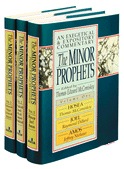
Although often overshadowed by the angst of their major counterparts, the Minor Prophets are a vital part of Scripture providing beauty, pathos, humility, and questioning. Based on the NRSV, this authoritative series features nine of the finest evangelical Old Testament scholars, insightful exposition, and meticulous exegesis of the Hebrew text. Each chapter is prefaced by an insightful introduction and provides meticulous exegesis of the Hebrew text. This commentary is a useful tool for both scholars and laypeople.
I've had volume one for a while. Yesterday, I began looking for the best price on vols. 2 & 3. However, this price at CBD is cheaper for the set than what I would pay for vols. 2 & 3 separately. I've got the set on order and I'll sell my duplicate copy of vol. 1 once the others arrive. Here is a list of contributors for this series:
VOLUME 1
Hosea: Thomas McComiskey
Joel: Raymond Dillard
Amos: Jeffrey Niehaus
VOLUME 2
Obadiah: Jeffrey Niehaus
Jonah: Joyce Baldwin
Micah: Bruce Waltke
Nahum: Tremper Longman III
Habakkuk: F. F. Bruce
VOLUME 3:
Zephaniah: J. Alec Motyer
Haggai: J. Alec Motyer
Zechariah: Thomas McComiskey
Malachi: Douglas Stuart
Bible Translation Awareness Survey Results
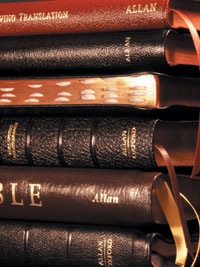
This was actually the third week I'd carried the survey with me as I was waiting for an ideal representation of our roll to respond. Yesterday we had 35 class members in attendance, no visitors, and about 10 of our regular attenders were absent. I handed out 35 surveys, but only got back 26. We are in a Southern Baptist church, and our class uses Southern Baptist curriculum.
Here is how I introduced the survey on the form I handed out to everyone:
Augustine said that it was profitable to study the Bible with parallel translations. On any given Sunday morning, there are multiple translations of the Bible represented in our Quest Bible Study—and that’s a good thing! This survey will help your teacher in his preparation by knowing what translations are in use in the class by what percentages of learners. Also, it will help him gauge your awareness of translations. Please answer the questions as honestly as possible.
Here are the results of the survey:
Q1. What translation of the Bible are you using this morning? [I had a list of translations to choose from including an option for other and an option for the Sunday School quarterly instead of a Bible]
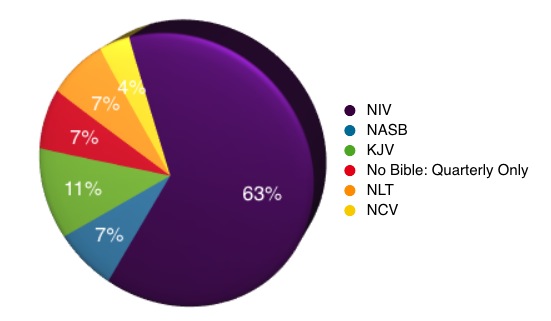
- 2 said they didn't bring a Bible, but were using a quarterly. This means they had access to the HCSB and KJV.
- 17 members were using the NIV. Our pastor preaches from the NIV, and of course, the NIV is the most popular translation in the US, so it no surprise that almost 2/3 of the class were using this version.
- 3 were using the KJV.
- 2 were using the NASB.
- 2 were using the NLT (I didn't specify which edition in the survey).
- We had one person respond saying he was using the NCV. I know of one other person in the class who uses the NCV, but he wasn't there today.
Q2. Did you know what translation you were using, or did you have to look at your Bible to double-check? [This was my awareness test. Assuming they answered truthfully, more folks are aware of their translation than what I would have imagined.]
Twenty-two answered "I knew"; three answered "I had to double-check."
Q3. What translation of the Bible does your teacher use? Don't guess. If you don't know, write, "I don't know."
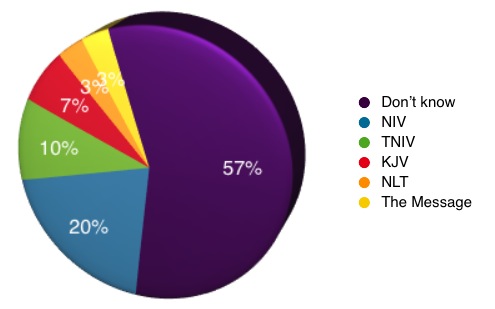
- 15 respondents said they didn't know what translation I was using.
- 6 said that I was using the NIV.
- 3 said I was using the TNIV.
- 2 guessed I was using the KJV!
- 1 suggested the NLT
- 1 thought I was using the Message.
The correct answer is that I use the TNIV. When we started the class last March with less than a dozen members, I was teaching from the HCSB because it is the primary translation in the Sunday School quarterly. However, last fall while teaching through Hebrews, I switched to the TNIV, so I've been using that for about six months. I did use the Message one time a few weeks ago to read through an extended passage in Esther. I mentioned that I was reading from that version, and that name must've stuck with someone. I have never and would never use the KJV to teach a regular Sunday School class. I've used the KJV occasionally in other venues, especially when speaking to senior adults.
I mention now and then that I am reading from the TNIV, but I don't make a big deal out of it.
Q4. When you study your Bible at home, do you ever use another translation? If so, list what you would consider your primary translation, and what you would consider any secondary translation(s). If you never study your Bible at home, simply write, “I never study my Bible at home” (this survey IS anonymous!).
One person admitted that no Bible study ever takes place at home. Here are the rest of the results:
Primary translations:
- NIV: 17
- NLT: 2
- KJV: 2
- NASB: 1
Secondary translations:
- KJV: 6
- NIV: 2
- NASB: 2
- HCSB 1
- NCV: 1
- NKJV: 1
- Amplified: 1
- Phillips NT: 1
Q5. If you lost your main Bible and had to buy a new one this week, would you buy the same translation you checked in question #1 or would you get a different one? If you would get a different one, what would it be?
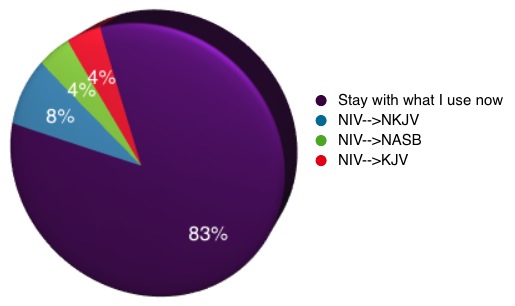
- 20 of those surveyed said that if they had to replace their Bibles, they would stick with the translation they currently use.
- Two said they would switch from the NIV to the NKJV.
- One indicated a switch from the NIV to the NASB.
- One said a switch from the NIV to KJV would take place.
Again, for anyone else, these results are simply anecdotal. But the majority of my class using the NIV reflects national trends. Further, if there're any broader implications to be drawn, question #5 would indicate that people don't change translations very often or very easily. Most importantly, my choice to teach from the TNIV is a good one with most of the class' members reading from the NIV. They can follow easily enough when I read from the TNIV as there is much continuity from their version, but at the same time the TNIV offers a more accurate and up-to-date option over the NIV.
One last thought... to my knowledge, there's been no recent class at our church about the history of English translations and the differences between them. I wonder if any of the questions would be answered differently if such a discussion took place prior to such a survey?
Link: Bible Translation Awareness Survey
Quest Bible Study Class Gets Mention from KBC
See "Sunday School New Birth Stories, part 3."
And if you're not in the class already, but if you're ever in the area, come join us at 10:30 a.m. on Sunday mornings.
The Grantham Bible Study Method
A Guest Post by Chuck Grantham
Rick has asked me to expand a bit on how I prepare for Sunday School for those who may not read the comments section.
The first thing I should say is that I do not teach a Sunday School class. I do this primarily for myself. On the other hand, I think any group of believers studying the Bible deserve good answers when they have questions, and the Learner Guide in the Lifeway Explore the Bible series, the Southern Baptist Convention’s Sunday School quarterly, cannot possibly address all the questions that can come up in your average class.
It is also a help to the actual teacher when someone can give a quick answer to those odd, even off-topic questions that come up, so the teacher can get back on topic. You culprits know who you are….
I should also add that this is a new routine for me, and is slowly evolving as I use it. It also varies a bit depending on the genre of the biblical book we are studying. For Old Testament history I do more historical study and less textual work because my Hebrew and my resources aren’t up to it. For the Gospels I do more synoptic comparison and non-canonicals research, because that‘s a scholarly trend right now and I am fascinated by the agrapha, even if Craig Evans dismisses it.
So as they say, this is where I am at right now, in regard to Sunday School preparation. Here are the steps as I can best outline them:
1. Read the lesson passage in the Learner book.
Of course, you’ve got to read the text first. This can involve different amounts of material. The lesson starts off with a title and then two sets of verses:
A) Background passage: the length of material assumed necessary to grasp the context of the lesson.
B) Lesson passages: those verses actually studied and commented upon in the Learner book.
Sometimes the background passage and the lesson passages are the same. Sometimes the background is several chapters and the lesson passages are the highlight verses within the background passage. My strong suspicion is most folk only read the lesson passages, and even that only in the translations provided in the Sunday School book.
Yes, I said translations. The Explore The Bible Learner Guide provides the lesson passages in side by side renderings from the Holman Christian Standard Bible and of course, the King James Version. This selection leads us to my next step.
2. Check HCSB and KJV for obvious differences.
I love parallel Bibles. But they can confuse someone who does not understand the background of translations. Not only do different Bibles read differently because of different translation philosophies (mirroring the original text versus mirroring contemporary speech of the translation‘s day, to grossly simplify) but also because translations are based upon different “original” texts. Speaking strictly of the New Testament, Older Roman Catholic Bibles were based upon the Latin Vulgate, which varied in places from the King James Bible, based upon Erasmus’ Greek New Testament. And both vary again from Bibles published in the last 130 years, when discoveries of massive numbers of Greek, Latin, Coptic, Syriac and many more language new testament manuscripts have led scholars to create several “standard” Greek New Testaments, which has further led to each new translation’s translator(s) being forced to decide in numerous places which Greek wording seems more original to them.
All of which is to say that the HCSB and the KJV do not always agree, and not only because centuries separate the vocabularies of the two. The venerable old KJV is based on Greek manuscripts from the Middle Ages, which tend to be more verbose in fear of leaving something good out. The HCSB is based on the current scholarly Greek New Testament, which tends to follow the earliest well-produced manuscripts, whose scribes had not yet added wordings to make things clearer or more reverent, and thus tends to be shorter.
So, after reading the HCSB and the KJV, I do a comparison of their wording, and I take a pen and circle the differences I see, either in vocabulary or in text. That gives me a series of verses which I can then use as a guide for the next step.
3. Check NET diglot for textual notes.
This is the first step where level of education rears its head. I personally have what might be described as “word study Greek.” I can read Greek letters and I know a lot of root words in the vocabulary. Thus I can use certain tools an English-only reader cannot. There are tools for the Greek-impaired to do these sort of things, too, though.
For those with Greek or without, the NET Bible First Edition is a great help, if you don’t let yourself be intimidated. With over 60,000 notes (compared to many study Bibles’ 20,000 notes) the NET is either a study Bible on steroids or an emaciated commentary. Besides the inevitable complaints about its translation philosophy, the NET’s chief strength is its greatest weakness: it has notes for every level of user. Simple definitions of terms sit alongside lengthy discussions of textual critical issues using manuscript numbers and Greek wording. Transliterations are provided as well as notes with “literal” translations of phrases, though.
My preferred edition of the NET when dealing with the New Testament (and we Christians usually are) is the NET Diglot. That is, a parallel Bible with the Nestle-Aland 27th (NA27) edition of the Greek New Testament combined with the NET English translation and notes. Why? Because I am a hopeless New Testament textual criticism geek. Reading the New Testament in Greek for most will simply confirm how careful most translations are to get things as right as they can. And because inevitably translators use
the same reference books and read each other’s translations, a good parallel English New Testament will reveal strong similarity in most Bible passages. But when they do differ, there is no better one stop resource than the NET diglot, which combines the mini-encyclopedia of the NET with the second mini-encyclopedia of the NA27, which endlessly footnotes even minor variations in the wording of NA27’s Greek text by citing which important manuscripts differ from the NA27, then which ones agree with NA27, then which important previous editions of the Greek New Testament agree or disagree with NA27. All of this together with an appendix citing the approximate age of the important manuscripts and what text of which New Testament books they contain.
All this can make for information overload, and the chief complaint against NA27 is that it requires one to learn practically another language in the form of NA27’s symbols and abbreviations to truly use it well. There are two solutions to this:
a) NET Diglot comes with a little foldout containing the witnesses, signs and abbreviations used in the NA27 that will be constantly in readers’ hand.
b) NET footnotes on the opposite page contain English sentences stating as simply as possible much the same information as abbreviated in the NA27 footnotes.
So, having found out what the NET Diglot says about the differences between HCSB and KJV, I will usually circle or underline the variation in the Learner book, draw a line out to the margin of the page, and write out a transliteration of the Greek, together with the earliest manuscript or two supporting each variation with rough date.
At this point I will also be mulling over other things I have learned from the footnotes on the NET side of the diglot, which I will have noticed mentions literal translations, other text critical issues, or even translation issues. But now it is time to go back to the Learner Guide for the next step.
4. Read the passage overview in lesson book, noting where the author keys on words, provides definitions or parallel verses.
In other words, grill the author on the assertions he makes. If he defines a word, I’ll circle it, find the Greek term in the diglot, see how NET translates it, and if I’m at all suspicious of the English term, walk over to my book case and pull out my copy of The New International Dictionary of New Testament Theology: Abridged Edition
Key words and parallel verses require more work and more tools. I will cross check the English against the Greek so I get one term, then for the key words simply see how often they are repeated in the Greek text. I do this with E-sword, the excellent FREE (mostly) Bible software. By simply highlighting the Greek word and clicking, I can run a search on the word in the current book or the New Testament. With a copy, a switch to the LXX, and a paste, I can further search for the word in the Old Testament. Even with my poor Greek, I can flip through English versions in E-sword and get a sense of the range of meaning for the word, and very often discover parallels to my New Testament text.
If this doesn’t satisfy me (and by now you realize I’m not easily satisfied) I can hit the books again. Specifically Goodrick, Kohlenberger and Swanson’s The Exhaustive Concordance to the Greek New Testament
This is the point scratch paper comes in handy. Among these many verses I will make note of the parallels quoted in the Learner book and my search I find significant. That leads me to the next step.
5. Significant parallels I paste together and print out in Greek and English, particularly where outright quotes from LXX or a usage determining a discussed word meaning occurs.
Simply put, I’ll cross check my scratch list, pick the most important, then make a file of the New Testament and Old Testament parallels in Greek and English which I resize as small as readable, then print up double-sided to be folded up and stuffed in my now bulging Leaner Guide, along with that possible article from NIDNTT.
6. I print out Robertson's Word Pictures in the New Testament
Because I need all the Greek help I can get, and because, to borrow from Rick Brannan, A.T. Robertson was a stud. Or to be more technical, because Robertson wrote a still highly regarded Greek grammar and he published Word Pictures after the papyri boom of the 1900s which changed forever our understanding of New Testament Greek.
7. I read Barclay's Daily Study Bible
Yes, it is only here I get to the commentaries proper. Unless I am cheating a bit. Which lately I am. I bought a copy of Thomas Schreiner’s 1 Peter, 2 Peter, and Jude in the NAC series)
Anyway, by this time I know enough about the lesson passage that I can run through the commentaries pretty quickly. Mostly I am looking for different material: cultural background, classical references, historical information. Besides the cultural, most of this will not likely come up in Sunday School. I make notes on my scratch paper, which is at least two sides of paper or two sheets by now.
8. I run off the appropriate page(s) from Bruce Metzger’s Textual Commentary on the Greek New Testament
Because I’m a textual criticism geek, but also because Metzger sometimes has odd little sidelines and Omanson discusses how segmentation can affect translation. And of course, Metzger is still THE Man.
9. I sit down with all these pages and put short notes in my Learner book.
Basically, I select what I find important, interesting, and/or easy to write briefly and write it up in the book where I will easily remember it. That usually includes Greek transliteration of key words or confusing terms in KJV along with definitions, notations of words not in the Greek supplied for English clarity, parallel verse notations, occasional flow charts of the author’s argument, and almost always questions about multiple interpretations of a phrase or verse. That’s a fair amount of black ink
scribbled in the book, along with that now sizeable sheaf of printouts in the center of the Learner Guide.
10. After a break of a day or two, I go back and review what I've compiled.
Like preparing for a test, I check to see what I remember and what I need to review. I will also likely scratch out some notes and add some new ones, because I see things more clearly after a break.
11. I go to Sunday School and never use ninety percent of what I've learned.
Because I’m not the teacher, and because I want to help my fellow members learn, not confuse them.
12. I come home from Church and after lunch start the process over again for the next week's Sunday School lesson.
Because I really enjoy all this study.
Thanks Chuck for sharing all this. I've heard it said (and I agree) that sincere study of the scriptures is just as valid of a style of worship as any other. I know many of This Lamp readers will relate to Chuck's enthusiasm for understanding the scriptures even if they have slightly different steps of their own. I can relate to Chuck because I've always said that I feel most alive when learning, and I feel most in God's will when I am teaching what I've learned.
Chuck Grantham can be reached at chuckgrantham@cableone.net, and I know he would appreciate your feedback in the comments.
Zondervan's NIV Archaeological Study Bible Revisited: New Printing Corrects Some Errors, But Leaves Others
In fact, because of my enthusiasm for the ASB, my wife and I purchased one for my brother-in-law last week as a Christmas present. While taking a copy off the shelf in the store, I immediately noticed that the dust jacket was the same height as the entire volume. Remembering that the dust jacket on my copy had been more of a wrap-around cover, I wondered if corrections had been made to the copy I held in my hand. I quickly turned to p. 101 to see if the Rosetta Stone was turned right-side up. It was! However, something still did not look right. More about this below.
The new printing (recognized by a full-length dust jacket in the hardback) should not be mistaken for a new edition of the ASB. Bibliographies for further research are still missing, and a few things have been changed, but unfortunately other things have not. The list below should not be considered a complete one, but rather my checks on the issues discussed in the comments of my previous review. It should be noted that Zondervan was made aware of the issues in my last post of the ASB and the comments pertaining to it.
- The front matter now includes a list of article contributors which was missing from the original edition. Articles are still not signed, but at least the contributors, many of which were graduate students are now given credit. However, I can no longer find their names or even the names of the editors on the ASB website., although the link included in the comments of my previous review still works. If I am overlooking a link still on the ASB site, someone can correct me.
- The spelling inconsistency of "mikveh" (p. 1648) and "miqveh" (p. 2085) remains. Neither one is incorrect, but usually in a work like this a consistent spelling will be adopted. Obviously, this is a minor issue, but I'm surprised it has not been caught.
- William Hallo's name is still misspelled as "Hallow" on p. xviii (p. xix in the original edition). I double-checked my own copy of The Context of Scripture yet again, and the name is indeed misspelled. This should have been a prioritized correction.
- The Masoretic Text in the glossary listing on p. 2085 is still listed as being housed at the Saint Petersburg Public Library, but this title is slightly incorrect. Technically the manuscript is housed in the Russian National Library (or the State Public Saltykov-Shchedrin Library), which technically is a public library in Saint Petersburg, Russia.
- Something I hadn't noticed before, and is probably picky to some, but Dr. Duane Garrett (who served as General Editor and Theological Review) is associated with the "Southern Baptist Seminary" on p. xviii instead of the "Southern Baptist Theological Seminary," the actual name of the school.
- Now about that Rosetta Stone on p. 101--good news and bad news. The good news, which I have already mentioned, is that the Rosetta Stone in the new printing is now right-side up:

In the photo above, I have laid the first printing on the left next to the recent printing on the right. In the original edition of the ASB, the Rosetta Stone was incorrectly placed upside down. The new printing places it right side up. But when I first looked at the "corrected" image while still in the store, something bothered me; something didn't seem right. When I got home I looked up the Rosetta Stone in a few of my own resources. Sure enough--it's still not correct. The picture in the book is actually a mirror image of the original Rosetta Stone. Compare, for instance, this image from the website of the British Museum where the stone is kept:
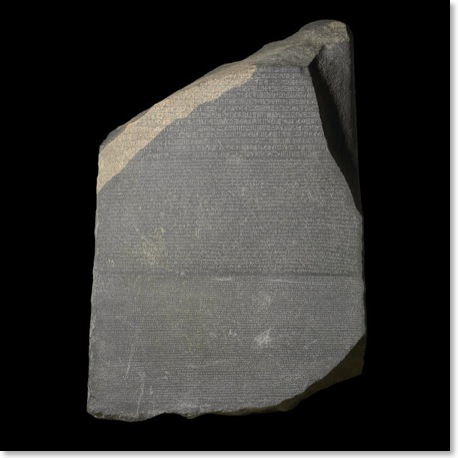
Obviously, the original blunder was worse, but one would think that an artifact as well-known as the Rosetta Stone could be displayed correctly.
In spite of these issues, I'm still very enthusiastic about the Archaeological Study Bible. I own one myself, and I just bought one as a Christmas present. However, before the next printing of this Bible, hopefully someone can really give it a fine-tooth proofread. This should probably be an expert in the field of biblical archaeology and backgrounds who did not work on the original project. It's often quite hard to proofread one's own mistakes because one knows how the work is supposed to read (happens here on my blog all the time).
One more thing... before posting this blog entry, I contacted Zondervan almost a week and a half ago to see if there was a complete list of corrections and changes available for this new printing of the ASB. Unfortunately, I have not heard from them yet, but if I find out there are more corrections, I will post them here.
Deal of the Day: Half Price on Renovaré Spiritual Formation Bible with Deuteroncanonicals
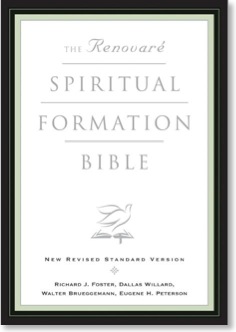
This is a hardcover Bible published by HarperCollins featuring the NRSV text. As far as I know, the special half price is available only at the Renovaré website.
If you aren't familiar with Renovaré, be sure to check out their website. If you aren't familiar with the Spiritual Formation Bible, below is the description from the HarperCollins site:
Many people are looking for a fresh way to read the Bible, not as a text to be mastered, but as a story to enter into and a lifestyle to pursue. In this unique Bible, the foremost names in Christian spirituality and biblical scholarship come together to provide a Bible that rediscovers Scripture as living text, rich with insights into how to live our lives more intimately with God.
Spearheaded by bestselling authors Richard J. Foster (Celebration of Discipline) and Dallas Willard (The Divine Conspiracy), The Renovaré Spiritual Formation Bible introduces the concept of the "with-God life," a model for seeing the whole of Scripture as the unfolding story of God's plan for our loving relationship with the Creator. This central theme weaves throughout the essays, introductions, notes, and exercises, powerfully revealing how God is present to his people today and throughout history.
Yet our relationship with God should not be passive. Concrete practices—Spiritual Disciplines—have been used throughout church history to guide disciples of Jesus. This Bible integrates the Spiritual Disciplines into the Christian life by showing how they are central to the Bible's teachings and stories. Abraham and Ruth, Moses and Deborah, Jesus and the disciples all provide amazing examples of the life-changing power of prayer, worship, fasting, celebration, and many other Spiritual Disciplines. Scripture thus becomes a primary means for the discovery, instruction, and practice of these disciplines as well as a tool for spiritual formation.
Combining the highest possible biblical scholarship with the deepest possible heart devotion, this new Bible project seeks to nourish inner transformation by unlocking and revealing the profound resources within Scripture for changing our hearts and characters and bringing them in line with what God wants for our lives. The Renovaré Spiritual Formation Bible will redefine what the Bible means for Christian discipleship.
This is a good price on a very unique Bible. And NO, I don't get a cut--I'm just passing along a good deal.
Bible Study with the Usual Suspects
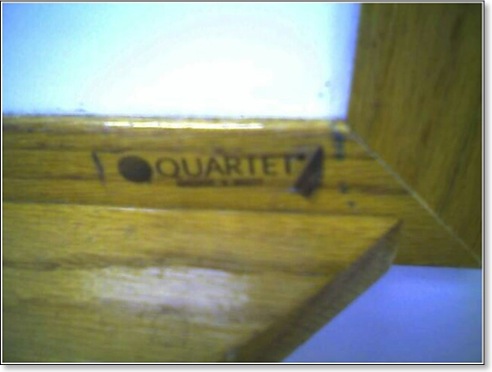
I finally remembered yesterday to take a picture of the whiteboard in one of our Sunday School classrooms. Pardon the poor quality, but it is the best my Treo can do.
This won't make any sense to you unless you've seen the movie Usual Suspects, but I was startled a few weeks ago to notice the sticker on one of our whiteboards that read "Quartet/Skokie, Illinois." I had no idea it was a real company.
And I tell you, that Verbal Kint fellow thinks he has to answer every question during our Bible study...
Review: The Zondervan TNIV Study Bible
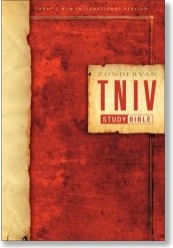
In comparing my 1985 NIV Study Bible to the new TNIV Study Bible, I notice that there have been a number of improvements to the layout. Dark red squares around chapter numbers allow readers to quickly fix their eyes at the beginning of the chapters. The boxes around page numbers and reference headings at the top of the page allow the reader to find the right page much much quicker. There are A's, B's, and C's in the study notes allowing the reader to quickly identify (A) Application Notes, (B) Background Notes, and (C) Character Information.
The font for the biblical text is slightly smaller than my copy of the first edition of the NIV Study Bible, but the difference is negligible. The font for the notes is sans-serifed unlike those in the NIV Study BIble, so that makes for darker print and easier reading.The pages are thin, but I have Bibles with much thinner pages, so this really seems to be a non-issue. Unfortunately the words of Christ are in red, something I really prefer a Bible not to have but at least it's not the bright red found in Bibles a generation or two ago, so I can live with it. However, I am greatly pleased that the editors decided to go with a single-column format instead of the two columns in the original edition.
If anything, what's most important is the content in the TNIV Study Bible. In comparing this Bible with my first edition, I notice about 300 pages of more content in the new Bible, which really would have been even greater if font size had not been reduced in the biblical text. The specs on the Amazon.com page report 2496 pages and that sounds about right. All of the notes (over 20,000), introductions (66), charts and timelines (39), maps (49 black & white in-text and 16 pages of satellite generated full-color maps) and tables have been updated to the TNIV, one of the most accurate contemporary translations available.
There are also seven essays scattered throughout the text on the following subjects:
1. The Conquest and the Ethical Question of War
2. Wisdom Literature
3. The Book of the 12 and the Minor Prophets
4. The Time Between the Testaments
5. The Synoptic Gospels
6. The Pastoral Letters
7. The General Letters
The reader will also find features such as an extremely detailed TNIV Harmony of the Gospels and a section on major archaeological studies relating to the New Testament. The person interested in Ancient Near Eastern literature will appreciate the annotated list of Ancient Texts Relating to the Old Testament.
Plus there are an incredible FIVE ways to find content: (1) an extensive TNIV concordance, (2) A biblical subject index (because sometimes you know the subject but not how its worded in the verse), (3) an index to the study notes, (4) an index to the black & white in-text maps and (5) an an index to the color maps. I don't think I've ever seen a Bible that approached finding information in so many ways.
The Zondervan TNIV Study Bible was just released this week. Since there was not a discount yet at Amazon, I tried to be a good Christian patron, but three of our local religious bookstores did not have it in stock (and of course, one particular chain I didn't even try because I knew they wouldn't have it). Fortunately I was able to procure it at one of our local Borders Bookstores. Of course, I imagine it will be in most regular outlets over the next few days and weeks.
I emailed Zondervan a few days ago asking why they weren't promoting it front and center at TNIV.com (there's no mention of it as of this writing). They sent me back a very friendly reply stating that they were waiting until all editions (leather, personal size, etc.) were released over the next few weeks and then they have a pretty big campaign planed for it as they see its release as a very big deal. Since there seems to have been very little promotion for the TNIV over the last few months, I'm very glad to hear this.
I bought a hardback copy (all that is available this week) because I plan to mainly use the TNIV Study Bible at home as a reference tool. Yes, this is a big Bible (almost 2500 pages and 3.82 lbs. according to Amazon), but it packs an entire library of information in about 2" of thickness. But if you plan to carry it to church or Bible study you might want to wait for one of the personal-size editions. This assumes, of course that your eyes are better than mine! Regardless of which size you prefer, I would unconditionally recommend this Bible for any believer at any stage of spiritual development. Take it with you to church or buy it as an extra reference Bible for your study. Either way, you can't go wrong.
The launch of the NIV Study Bible in 1985 was significant because up until then, most study Bibles had revolved around one person's or one theological system's interpretation. The NIV Study Bible was a huge contribution because it delivered biblical background, exegesis and commentary from dozens of the finest scholars in the evangelical world. As I look around at the scope of study Bibles today, I still see a lot more of the same, but perhaps even more specialized toward someone's perspective or a particular theological system. That's not to say that those perspectives don't have valuable points of view to offer, but in a study Bible I prefer the checks and balances of a more diverse approach. The title across the font of the TNIV Study Bible's dust jacket reads "Today's most comprehensive study Bible." Like it's predecessor, the TNIV Study Bible stands on solid ground as being exactly that and a fine inheritor to a great tradition.
Of Related Interest:
- My Review of the TNIV Translation
- Follow-Up to My Review of the TNIV









